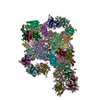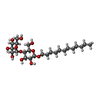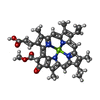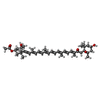[English] 日本語
 Yorodumi
Yorodumi- PDB-8j0d: FCP heterodimer, Lhca2, and Lhcf5 together as the M1 side binds t... -
+ Open data
Open data
- Basic information
Basic information
| Entry | Database: PDB / ID: 8j0d | ||||||
|---|---|---|---|---|---|---|---|
| Title | FCP heterodimer, Lhca2, and Lhcf5 together as the M1 side binds to the PSII core in the diatom Thalassiosira pseudonana | ||||||
 Components Components |
| ||||||
 Keywords Keywords | PHOTOSYNTHESIS / FCP / heterodimer | ||||||
| Function / homology |  Function and homology information Function and homology informationlight-harvesting complex / photosynthesis, light harvesting in photosystem I / plastid / chlorophyll binding / response to light stimulus / membrane Similarity search - Function | ||||||
| Biological species |  Thalassiosira pseudonana (Diatom) Thalassiosira pseudonana (Diatom) | ||||||
| Method | ELECTRON MICROSCOPY / single particle reconstruction / cryo EM / Resolution: 3.19 Å | ||||||
 Authors Authors | Li, Z. / Feng, Y. / Wang, W. / Shen, J.R. | ||||||
| Funding support |  China, 1items China, 1items
| ||||||
 Citation Citation |  Journal: Sci Adv / Year: 2023 Journal: Sci Adv / Year: 2023Title: Structure of a diatom photosystem II supercomplex containing a member of Lhcx family and dimeric FCPII. Authors: Yue Feng / Zhenhua Li / Xiaoyi Li / Lili Shen / Xueyang Liu / Cuicui Zhou / Jinyang Zhang / Min Sang / Guangye Han / Wenqiang Yang / Tingyun Kuang / Wenda Wang / Jian-Ren Shen /   Abstract: Diatoms rely on fucoxanthin chlorophyll -binding proteins (FCPs) for their great success in oceans, which have a great diversity in their pigment, protein compositions, and subunit organizations. We ...Diatoms rely on fucoxanthin chlorophyll -binding proteins (FCPs) for their great success in oceans, which have a great diversity in their pigment, protein compositions, and subunit organizations. We report a unique structure of photosystem II (PSII)-FCPII supercomplex from at 2.68-Å resolution by cryo-electron microscopy. FCPIIs within this PSII-FCPII supercomplex exist in dimers and monomers, and a homodimer and a heterodimer were found to bind to a PSII core. The FCPII homodimer is formed by Lhcf7 and associates with PSII through an Lhcx family antenna Lhcx6_1, whereas the heterodimer is formed by Lhcf6 and Lhcf11 and connects to the core together with an Lhcf5 monomer through Lhca2 monomer. An extended pigment network consisting of diatoxanthins, diadinoxanthins, fucoxanthins, and chlorophylls is revealed, which functions in efficient light harvesting, energy transfer, and dissipation. These results provide a structural basis for revealing the energy transfer and dissipation mechanisms and also for the structural diversity of FCP antennas in diatoms. | ||||||
| History |
|
- Structure visualization
Structure visualization
| Structure viewer | Molecule:  Molmil Molmil Jmol/JSmol Jmol/JSmol |
|---|
- Downloads & links
Downloads & links
- Download
Download
| PDBx/mmCIF format |  8j0d.cif.gz 8j0d.cif.gz | 248.2 KB | Display |  PDBx/mmCIF format PDBx/mmCIF format |
|---|---|---|---|---|
| PDB format |  pdb8j0d.ent.gz pdb8j0d.ent.gz | 204.8 KB | Display |  PDB format PDB format |
| PDBx/mmJSON format |  8j0d.json.gz 8j0d.json.gz | Tree view |  PDBx/mmJSON format PDBx/mmJSON format | |
| Others |  Other downloads Other downloads |
-Validation report
| Summary document |  8j0d_validation.pdf.gz 8j0d_validation.pdf.gz | 4.9 MB | Display |  wwPDB validaton report wwPDB validaton report |
|---|---|---|---|---|
| Full document |  8j0d_full_validation.pdf.gz 8j0d_full_validation.pdf.gz | 5.1 MB | Display | |
| Data in XML |  8j0d_validation.xml.gz 8j0d_validation.xml.gz | 81.1 KB | Display | |
| Data in CIF |  8j0d_validation.cif.gz 8j0d_validation.cif.gz | 99.4 KB | Display | |
| Arichive directory |  https://data.pdbj.org/pub/pdb/validation_reports/j0/8j0d https://data.pdbj.org/pub/pdb/validation_reports/j0/8j0d ftp://data.pdbj.org/pub/pdb/validation_reports/j0/8j0d ftp://data.pdbj.org/pub/pdb/validation_reports/j0/8j0d | HTTPS FTP |
-Related structure data
| Related structure data |  35899MC  8iwhC M: map data used to model this data C: citing same article ( |
|---|---|
| Similar structure data | Similarity search - Function & homology  F&H Search F&H Search |
- Links
Links
- Assembly
Assembly
| Deposited unit | 
|
|---|---|
| 1 |
|
- Components
Components
-Protein , 2 types, 2 molecules 34
| #1: Protein | Mass: 24100.990 Da / Num. of mol.: 1 / Source method: isolated from a natural source / Source: (natural)  Thalassiosira pseudonana (Diatom) / References: UniProt: B8BUU4 Thalassiosira pseudonana (Diatom) / References: UniProt: B8BUU4 |
|---|---|
| #2: Protein | Mass: 17745.100 Da / Num. of mol.: 1 / Source method: isolated from a natural source / Source: (natural)  Thalassiosira pseudonana (Diatom) / References: UniProt: B8BVI1 Thalassiosira pseudonana (Diatom) / References: UniProt: B8BVI1 |
-Fucoxanthin chlorophyll a/c protein ... , 2 types, 2 molecules 56
| #3: Protein | Mass: 17614.867 Da / Num. of mol.: 1 / Source method: isolated from a natural source / Source: (natural)  Thalassiosira pseudonana (Diatom) / References: UniProt: B8BX92 Thalassiosira pseudonana (Diatom) / References: UniProt: B8BX92 |
|---|---|
| #4: Protein | Mass: 18380.953 Da / Num. of mol.: 1 / Source method: isolated from a natural source / Source: (natural)  Thalassiosira pseudonana (Diatom) / References: UniProt: B8CEV5 Thalassiosira pseudonana (Diatom) / References: UniProt: B8CEV5 |
-Sugars , 2 types, 3 molecules 


| #11: Sugar | ChemComp-DGD / |
|---|---|
| #13: Sugar |
-Non-polymers , 7 types, 71 molecules 












| #5: Chemical | ChemComp-CLA / #6: Chemical | #7: Chemical | ChemComp-A86 / ( #8: Chemical | #9: Chemical | #10: Chemical | ChemComp-LHG / #12: Chemical | |
|---|
-Details
| Has ligand of interest | Y |
|---|
-Experimental details
-Experiment
| Experiment | Method: ELECTRON MICROSCOPY |
|---|---|
| EM experiment | Aggregation state: PARTICLE / 3D reconstruction method: single particle reconstruction |
- Sample preparation
Sample preparation
| Component | Name: M1 local refinement in the PSII-FCPII from the Thalassiosira pseudonana at 3.19 angstrom Type: COMPLEX / Entity ID: #1-#4 / Source: NATURAL |
|---|---|
| Source (natural) | Organism:  Thalassiosira pseudonana (Diatom) Thalassiosira pseudonana (Diatom) |
| Buffer solution | pH: 6.5 |
| Specimen | Embedding applied: NO / Shadowing applied: NO / Staining applied: NO / Vitrification applied: YES |
| Vitrification | Cryogen name: ETHANE |
- Electron microscopy imaging
Electron microscopy imaging
| Experimental equipment |  Model: Titan Krios / Image courtesy: FEI Company |
|---|---|
| Microscopy | Model: FEI TITAN KRIOS |
| Electron gun | Electron source:  FIELD EMISSION GUN / Accelerating voltage: 300 kV / Illumination mode: FLOOD BEAM FIELD EMISSION GUN / Accelerating voltage: 300 kV / Illumination mode: FLOOD BEAM |
| Electron lens | Mode: BRIGHT FIELD / Nominal defocus max: 2000 nm / Nominal defocus min: 1000 nm |
| Image recording | Electron dose: 60 e/Å2 / Film or detector model: GATAN K3 BIOQUANTUM (6k x 4k) |
- Processing
Processing
| EM software | Name: PHENIX / Version: 1.19.2_4158: / Category: model refinement | ||||||||||||||||||||||||
|---|---|---|---|---|---|---|---|---|---|---|---|---|---|---|---|---|---|---|---|---|---|---|---|---|---|
| CTF correction | Type: PHASE FLIPPING AND AMPLITUDE CORRECTION | ||||||||||||||||||||||||
| 3D reconstruction | Resolution: 3.19 Å / Resolution method: FSC 0.143 CUT-OFF / Num. of particles: 97098 / Symmetry type: POINT | ||||||||||||||||||||||||
| Refine LS restraints |
|
 Movie
Movie Controller
Controller



 PDBj
PDBj













